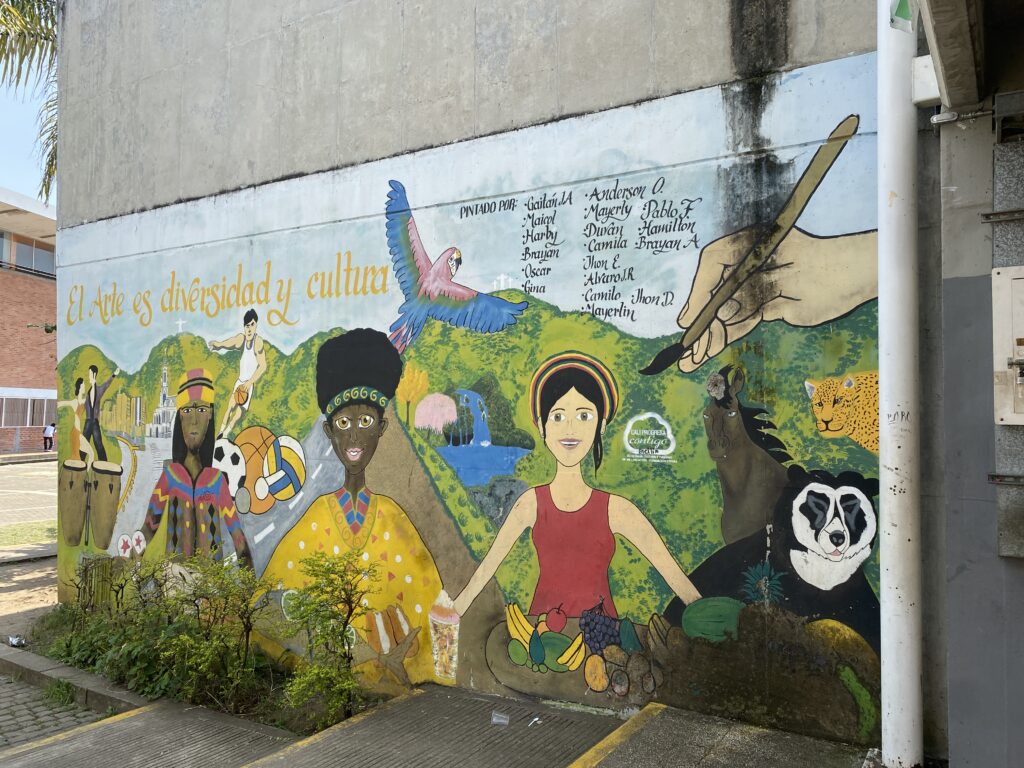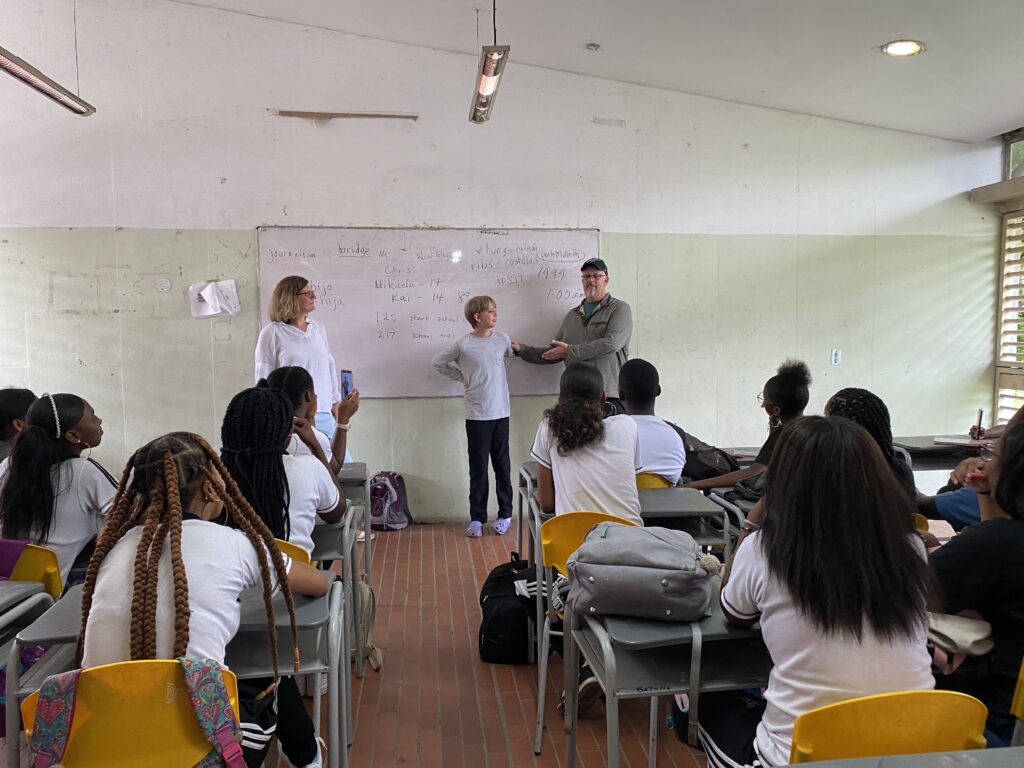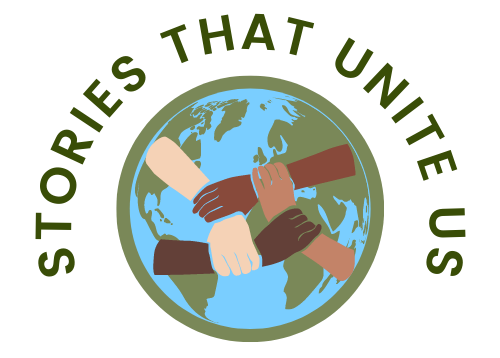I’ve finally started making progress with my project and it’s so fun to be working with high school students and their English teachers. Although the schools I’m visiting are in some ways very different from the high school where I work in New Hampshire, there are also many similarities. In my observations so far, teens are the same in both worlds and most likely, all over the world!
A little bit about school in Colombia…elementary school is from 1st-5th grade and high school is 6-11 grade; there is no middle school, but the high school is divided into 6-9th grade and 10-11th grade. There is no 12th grade in public schools! Here in Cali there are many public and private schools. Most private schools have a 12th grade and they also run on a different schedule. Public schools run from Feb – Nov and private schools from Sept – June.
My first school visit was to I.E. (Instituto Educativo) Duarte Cancino, which is a branch of the Nuevo Latir school in a neighborhood called Aguas Blancas, which is considered a Stratus 1 neighborhood (the lowest economic level and known for not being a safe area). The school has 1,200 students in Grades 1-11 and it is predominantly black, or afro, as they refer to themselves. At Duarte Cancino, I first met Ana, the principal and Jaime, the director of discipline. They shared that there is luckily a hospital across the street from the school, because there’s an average of 5 fights a day, and they often rely on the hospital for related medical issues. Jaime said that his biggest struggle is communicating with parents, they do not reply to messages. He said he could be with a student at the hospital, but they can not be treated without parental consent, and the parent will not answer the phone after many attempts. Ana explained that the biggest issue for her is absenteeism and on average, most students are absent 2-3 days a week.
On my second school visit, I went into a 10th grade English class. The teacher, Beatriz, was very excited to have me talk to her class and carry out my podcast project. The students were amazing! They were so excited to have me there. Many told me it was their first time meeting an American and they wanted to know why I picked their school to come to. In class, I told about myself, my town, and my school, mostly in English, while students yelled out the translation, competing to see who understood first and correctly. They understood quite a bit and they were definitely engaged. By the end of class, all the students had brought their chairs to the front of the room to be able to hear me and they were shushing each other whenever I spoke.
The rooms are open to the outside and made of cement, so the acoustics are terrible and the students were talking loudly…but when I spoke English, they got quiet. My first class had about 24 students, but the last block had 36 – that was loud! There was also a strong smell of burning charcoal in the classroom, with a light haze. The teacher told me that there is a charcoal brick making plant next door and some days it smells worse than others. There are no fans in the rooms and it got pretty hot and the “noseeums” were pretty bad.
School starts at 7:00am and ends at 12:50pm and they have 30 minutes for a breakfast, which is free for all students. During the breakfast break, I accompanied the English teacher on her cafeteria duty, where I quickly became surrounded by students of all ages asking a million questions: Where are you from? How did you get here? How much did it cost to get here? Have you ever seen snow? Can I go back to the US with you? And every now and then, I’d answer in English or ask them in English, “what is your name?” and they would run away screaming in shyness and embarrassment, only later to return with more friends. They were so intrigued and excited.
The next time I returned to that school, a younger student came up to me in the courtyard and said “Are you the American?” When I said yes, she was so excited and told me “The whole school is talking about you. We’ve never met an American before. Everyone is talking about you.” I felt like a celebrity! And that celebrity status tripled when I brought my friends from Connecticut to some classes. The students were so excited (and loud) and wanted to learn. They had so many questions, but also wanted to share their own stories.
After I shared a little about myself in English, and asked them a few questions in English, I told them they could ask me anything they wanted to know about the US, in Spanish. Here are some of the questions… (in no particular order).
- How do you celebrate funerals in the US?
- What are your school rules on cell phones?
- Do students in US schools wear uniforms? What is the dress code?
- Is there racism in your school?
- Are there blacks in your school?
- Are there fights in your school?
- Do they sell “Scott” brand toilet paper in the US? (they thought it was funny because it’s a common last name they have seen on TV, and how could someone be named after TP)
- How can I go to the US?
- How much is a ticket from Cali to Boston? How long is the flight?
- Do students have jobs? At what age?
- When can you get a driver’s license in the US?
- Lots of questions about how much things cost, salaries, minimum wage, etc.
- What are the safest American universities?
- Is it true that the US is more dangerous than Colombia?
- How long will it take me to learn English?
- What American musicians have you met in person?
- Are American soccer players good?
But the hardest question to answer, that I heard often, was “why do people bring guns to schools in the US and shoot innocent kids?” My answer “I have no idea. It’s horrible!” One student said that they would never go to school in the US, because they think Colombian schools are much safer.
I have only spent 4 days in this school so far, and it’s been an amazing experience. I was able to record 8 podcasts and hear some more of their personal stories and opinions on a variety of topics. In general, the students are growing up in challenging situations, but they are so excited to learn and mostly learn about places outside of the world of their neighborhood. They are smart, inquisitive and happy. I noticed how they support each other and they respect their teachers. I will return to this school often and I look forward to learning more from these amazing students.



